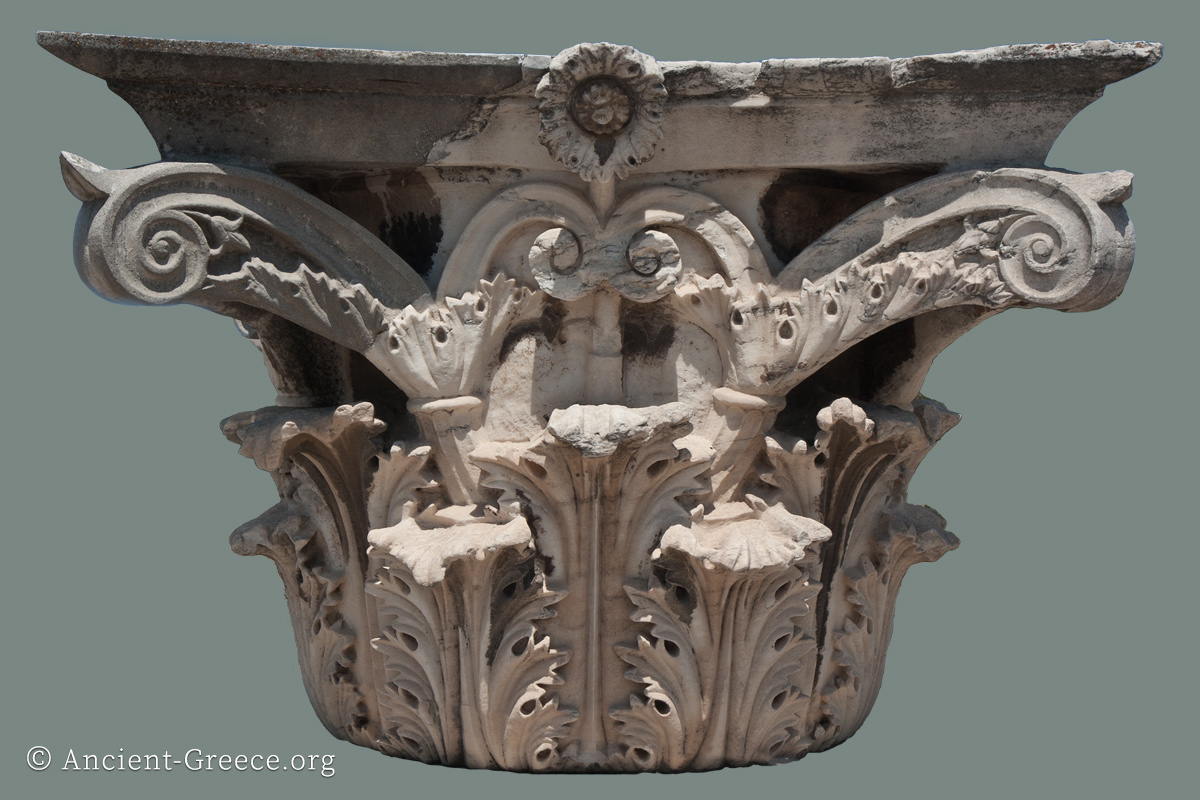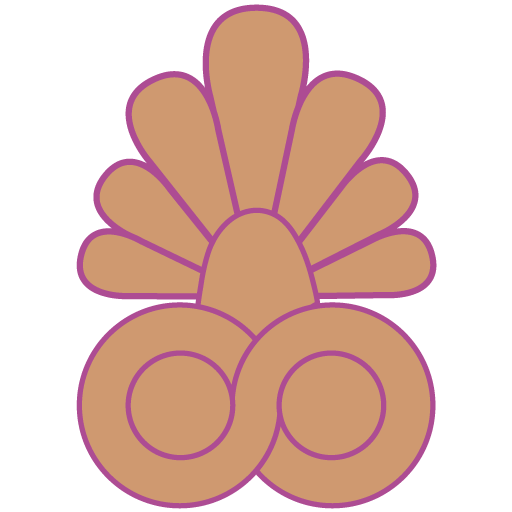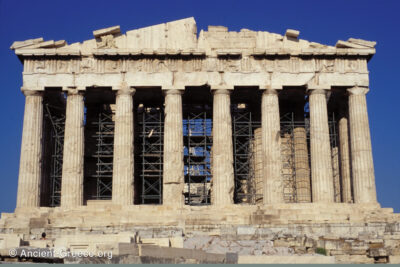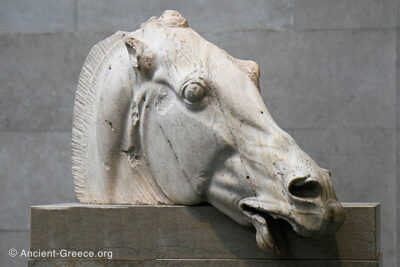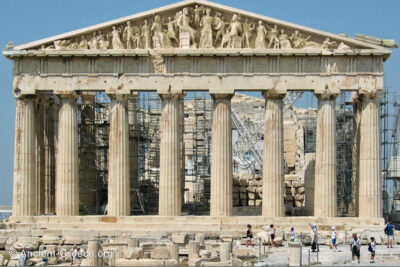
On this page:
Rediscovering the Temple’s Colors
The colors of the Parthenon have washed away over the past 2400 years, but pigment remnants can still be traced on certain surfaces, so we know that the building was colored. But was every surface covered in color? Were the colors vivid, soft like pastel, or a wash like watercolor? We can not be certain.
Several different interpretational drawings have been produced since the 19th century CE. Scholars like Durm, Loviot, Paccard,, Semper, Springer, Windstup, created conflicting educated reproductions, some with vivid, some with bright, and some without much color. But even in their divergence, they provide some guidance on the placement and type of colors and about the polychrome nature of the temple.
Analysis of the temple’s pigment remnants by the Acropolis Restoration Service in 2024 revealed that the flat background of the tested metopes contains remnants of red and red-orange pigment, while the flat bands that frame each at the top and bottom have remnants of blue, including Egyptian blue on the top band. (Αγγελακοπούλου, 1:01:18).
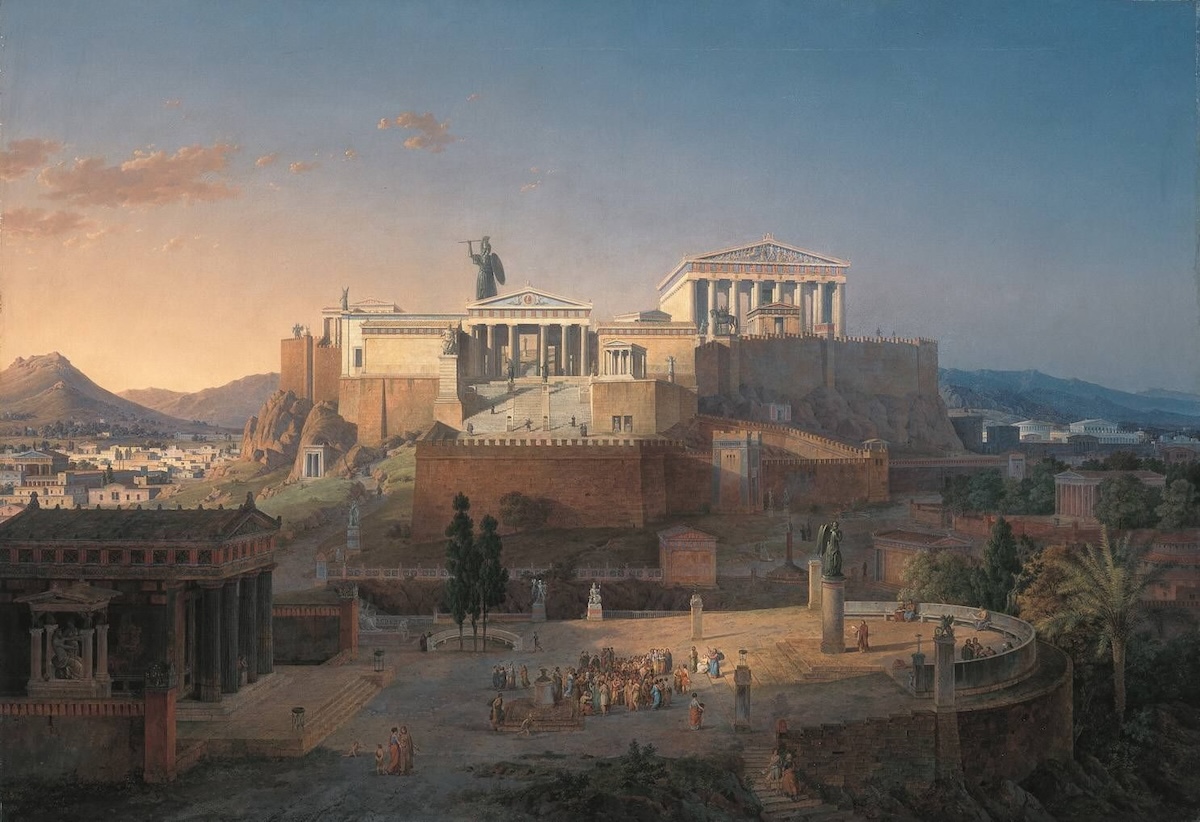

Pigment and Binder
What we know colloquially as “paint” is actually a substance made of “pigment” suspended in a “binder” which is applied as a thin covering on a “substrate”. The pigment provides the color, the binder “carries” and adheres the pigment to a substrate (marble in the case of the Parthenon).
Pigments used on marble in ancient times were derived from colored earth (red, red-orange, yellow, brown ochre), minerals (azurite, malachite, conichalkite, and cinnabar), and chemicall processes (Egyptian blue, lead white, minium, carbon black).
A gross approximation of known color pigments used in Classical Greece:
Earth:
red ochre
red ochre
brown ochre
yellow ochre
Mineral:
cinnabar
azurite
malachite
conichalkite
Chemical:
minium
Egyptian Blue
lead white
carbon black
Microscopic traces of beeswax found alongside pigment on some temple surfaces, along with the inscriptions listing the encaustic painters who were employed on the Acropolis, indicate that the pigments were most likely applied to the marble with wax through the encaustic method, at least on these test spots.
Wax as Binder and Sealant
Wax as a paint binder was used for centuries in ancient Greece. On the Parthenon, pigment was mixed into the molten wax and then applied directly to the marble.
While wax is an excellent binder for paint, we can reasonably assume that it was also coveted for its durability and protective properties.
Wax has been a traditional method for protecting and polishing stone sculpture because it is durable and elastic, responding well to temperature fluctuations over time. Wax is also a very versatile and can be thinned or thickened by mixing it with other waxes, turpentine, oils, resins, or fats. In sculpture-polishing, wax is applied as a paste and then is repeatedly rubbed vigorously with a wool cloth into the surface. Repeated layers increase the sheen.
Without pigment, a layer of wax enhances the stone’s natural beauty, giving it a permanent “wet” and bright look.
The Encaustic Method
In Encaustic painting, pigment is mixed in with hot wax. It is also know as “hot wax painting” because using heat is an integral part of the process.
The process of encaustic painting starts with keying (roughing-up) the stone with chisels to facilitate better adhesion of the paint. Evidence of keyed marble with tooth chisel marks under some tested surfaces on the Parthenon add to the evidence that the encaustic method was in use.
Then torches, heated metal spatulas and cloth or leather pads are used to apply and spread the pigmented wax and to smooth its surface.
Slight heating melts the wax into the keyed surface, seals the stone porous and produces a degree of sheen as the top of the mixture is polished, allowing light to penetrate easily all the way to the marble before it carries the color to the viewer’s eyes.
Color was an Integral Part of the Temple
Painting the Parthenon was an important part of the building process, and as the “final touch” it required the services of the best artisans who procured the best materials available for the task. The Erechtheion inscriptions indicate that “ενκαυταί” (encaustic artisans) were paid 5 oboli per foot of completed work.
The temples’ cornice that wraps around the temple has traces of an intricate grid which was used to guide artisans while painting geometric patterns like the meander.
Why we Cannot be Certain of the Overall Aesthetic Look
The precise process and application of paint affects the final appearance of the color. Not knowing that, hinders our ability to visualize precisely what the temple looked like.
Extra buffing of the wax would produce a glossy effect and more vivid color, while less buffing would make the colors look matte, as most of the light diffuses on the very surface of the paint layer.
Additionally, if pigment concentrations in the wax are low, more light will reflect off the white marble below and the color would look pale but more luminous. If more pigment is mixed in the wax, the color would appear rich and deep.
We also don’t have any information on the actual application of the paint. The effect of a painting that was painted in successive transparent layers is very different than one that was painted with opaque colors. And, in any case, an encaustic painting effect is very different than tempera or modern paint (like acrylic) which adhere to a substrate like “skin” and don’t allow light to penetrate far below their surface.
The encaustic method would have made the colored parts of the temple appear deep and rich, similar to a precious stone in various states of polish.
In conclusion, we know some of the colors that were used on the Parthenon and its sculptures, but without information on the precise process, the degree of pigment saturation in the binder, and the actual application style, we cannot be sure what the overall final visual effect of colored temple was.


Related Pages
